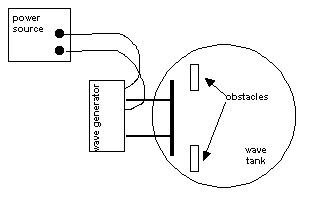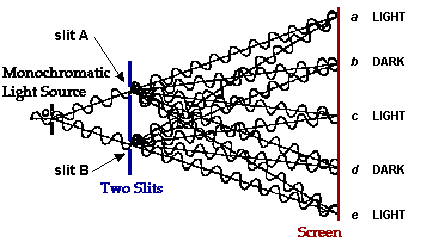
| Click to Run |
Wave Theory of Light
Part 1: Huygen’s Principle
Useful Resources:
Huygen’s Principle
http://www.colorado.edu/physics/phys1230/phys1230_fa01/topic14.html
Diffraction and Interference
http://labman.phys.utk.edu/phys136/modules/m9/diff.htm
Huygen’s Principle Animations
http://zonalandeducation.com/mstm/physics/waves/propagation/huygens1.html
Use a wave tank on a desk over a large piece of white paper. Use the plane wave attachment (a long piece of wood) on the wave generator. Hook the wave generator up to a low voltage DC power supply. Set up a light source over the wave tank. Darken the other lights in the room. Observe what a plane wave looks like (you will see bands of light and dark on the paper underneath) and then set up obstacles as shown in the diagram. Start with a large space between the obstacles.

1. Sketch a plane wave with no obstacles.
2. Sketch the plane wave after it passes through a wide space.
3. Sketch the plane wave after it passes through a medium space.
4. Sketch the plane wave after it passes through a narrow space.
5. Using the simulation above, choose "water," "one drip," and "one slit." Set the "slit width" to 5, the "barrier location" to 6.2, and the frequency at maximum. Sketch and describe the shapes of the wavefronts before and after the barrier.
6. Repeat #5 for a "slit width" of 2.5 and 1.
7. Using a physics book or the internet as a reference, state Huygen’s Principle and explain how this experiment illustrates it.
Part 2: Interference in a Wave Tank
1. Connect two point source attachments to the waver generator. Put them at one edge of the tank. Draw and describe what you see.
2. Check your observations with the simulation at the top of the page. (two drips, spacing=5, frequency at maximum. Draw and describe what you see.
3. Look at the diagram below to help you understand what you saw in #1. The dotted lines represent troughs and the dark solid lines represent crests. Draw a large dot at all the points where a crest intersects a trough. With a marker, connect the dots with smooth curves. These nodal lines lie in regions where waves have canceled (destructive interference). Repeat this exercise by connecting all points where troughs and troughs or crests and crests intersect. Connect these points with a different colored marker. What do these lines represent?

Part 3: Young’s Interference Experiment
1. Obtain a plate with two thin slits cut into it. Draw what you would expect to see on a screen if you shone a light through these slits.

3. Repeat #2 using a blue filter. Draw what you see. How is this image different from that of the one with the red filter? You can put a red filter over the top half of the slits and a blue filter over the bottom half so that you can compare the images simultaneously.
4. Check your observations with the simulation. Close the simulation and open it again to reset it to the default settings. Click the "light" tab and change it to "two slits." Click "show screen" and then "intensity graph." Observe for red and blue light. Does this agree with your observations in #2 and #3? If not what do you see?
4. How do you think your results give evidence for the wave nature of light? Compare what you see what you observed with water waves.
The following diagram shows the path of light waves in Young’s experiment.

slit A and point a: _____
slit B and point a: _____
slit A and point b: _____
slit B and point b: _____
slit A and point c: _____
slit B and point c: _____
6. When the number of wavelengths along each path is the same or differs by one or more WHOLE wavelengths, interference is constructive or destructive?
When the number of wavelengths along each path is the same or differs by a HALF wavelength (or odd multiples of a half wavelength), interference is constructive or destructive?
7. Using a physics book or the internet, summarize Young’s experiment and explain how it gives evidence for the wave nature of light.